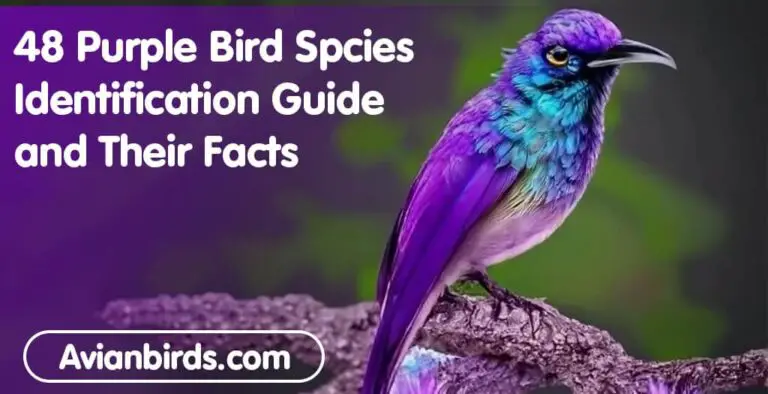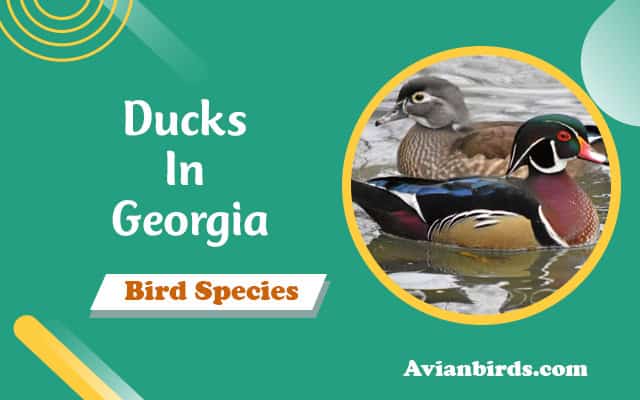6 Types of Flamingo: Fascinating Facts About These Pink Birds
Did you know there are six flamingo types of species on our planet? The Caribbean flamingos have over 200,000 in the wild. On the other hand, the Andean flamingos are much rarer, with fewer than 40,000.
These pink birds are known for their vibrant looks and social ways. We’ll dive into their color, species, and interesting facts. You’ll see how adaptable and important they are to our ecosystem.
Introduction to Flamingos
The types of Flamingo are known for their bright pink feathers. They live in shallow lakes and wetlands around the world. These birds are part of a group of six living species.
Each species has its special traits. The Greater flamingo is tall, while the Lesser flamingo is smaller. They all have amazing ways to live in their homes.
We love flamingos for more than their looks. Learning about their biology and behavior helps us understand their role in nature. They eat small shrimp and algae, which makes their feathers pink.
Flamingos live in big groups, sometimes with over a million birds. They have complex social lives and beautiful courtship dances. Studying flamingos helps us see how important they are to their ecosystems.
| Flamingo Species | Height (ft) | Weight (lbs) | Wingspan (in) |
|---|---|---|---|
| Greater Flamingo | 3.9 – 4.7 | 4.4 – 7.7 | 37 – 59 |
| Lesser Flamingo | 2.6 | 4.4 | None are documented, but ongoing efforts in conservation biology aim to protect their habitats. |
| Chilean Flamingo | 3.3 – flamingos are found in various habitats around the world. – 3.6 – flamingos also thrive in both wild and captive environments. | 5.5 – 6.6 | None documented |
| James’s Flamingo | 3.3 | 4.4 – 6.6 | None documented |
| Andean Flamingo | 3.3 | 5.5 – 6.6 | None documented |
| American Flamingo | 3.3 | 4.4 – 8.8 | None documented |
Flamingos’ Color: The Pink Phenomenon
Flamingos are known for their bright pink color. This color comes from their diet. Carotenoids in algae and crustaceans make their feathers pink.
The Role of Carotenoids in Their Diet
Carotenoids give flamingos their red, orange, and yellow colors. They eat algae and brine shrimp, getting lots of beta-carotene. This pigment turns their feathers pink.
The color of flamingos can change based on where they live and what they eat. For example, Caribbean flamingos are often red or orange. Those in drier areas are paler.
How Diet Transforms Their Plumage
Flamingos start gray and turn pink over time. It takes them up to two years to get their full color. Their diet affects how bright their feathers are.
Flamingos keep their feathers looking good by preening with oils. This helps keep their color from fading in the sun.
| Flamingo Species | Coloration | Dietary Influence |
|---|---|---|
| Greater Flamingos | Pale pink with bright pink wing coverts | Moderate carotenoid intake |
| Lesser Flamingos | Deeper pink | Rich in Spirulina algae |
| Chilean Flamingos | Muted pink with grayish tints | Varying carotenoid levels |
| Andean Flamingos | Pale pink with black and yellow highlights | Low carotenoid availability |
| James’s Flamingos | Pale pink with brighter accents | Moderate carotenoid consumption |
| American Flamingos | Vivid reddish-pink | High carotenoid intake |
The Six Types of Flamingo
Flamingos are fascinating, with six species each having unique traits and homes. Knowing about these species shows us the beauty of bird diversity. Let’s look at the different flamingo species, including the million lesser flamingos, and what makes them special.
Overview of Flamingo Species
Four flamingo species live in the Americas. Two species call Africa, Asia, and Europe home. Each species shows how adaptable and strong these birds are.
Unique Features of Each Species
| Species | Height (ft) | Weight (lbs) | Coloration | Habitat |
|---|---|---|---|---|
| types of Greater Flamingo | 3.9 – 4.7 | 4.6 – 9 | Pale pink to deep crimson | Africa, Asia, Europe |
| Lesser Flamingo | 2.6 – 2.9 | 3.3 – 4.4 | Light pink to darker shades | Southern Africa, Southern Asia |
| Chilean Flamingo | 3.3 – 3.6 | 4.4 – 5.5 | Bright pink | South America |
| Andean Flamingo | 3.3 – 3.6 | 4.4 – 6.5 | Light pink | South America |
| James’s Flamingo | 2.9 – 3.2 | 4.4 – 6.5 | Pale pink | South America |
| Caribbean Flamingo | 3.3 – 4.6 | 4.4 – 8.8 | Brightest pink | Florida, Caribbean |
1. Greater Flamingo
The Greater Flamingo is types of Flamingo is the tallest, growing up to 3.9 to 4.7 feet tall. It has pinkish-white feathers and a long neck. You can find it in Africa, Southern Europe, and Southwest Asia.

2. Lesser Flamingo
The Lesser Flamingo is the smallest types of Flamingo, growing to about 2.6 feet tall. It’s known for its bright colors and lives in Africa’s alkaline lakes. It has a dark red beak and yellow-orange eyes.
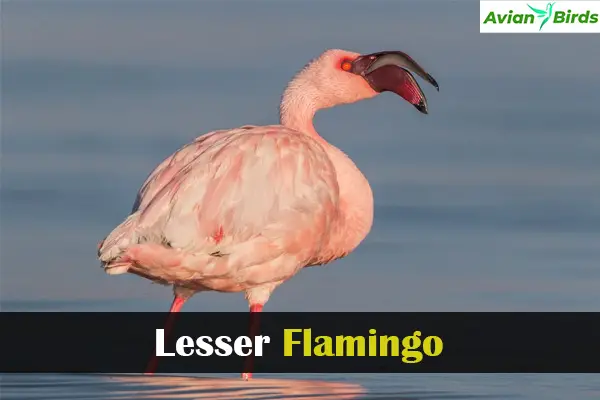
3. Chilean Flamingo
The Chilean Flamingo has pale pink feathers and grey legs with pink joints. It lives in South America’s temperate areas. This bird is important for keeping wetlands healthy.
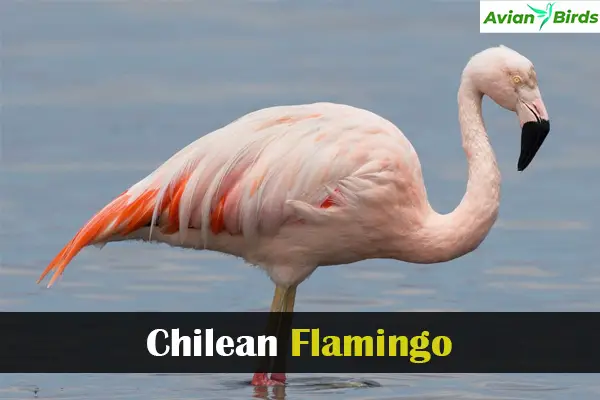
4. American Flamingo
The types of American Flamingo also called the Caribbean Flamingo, has bright pink feathers and orange-yellow eyes. It loves warm coastal spots. Its diet gives it its bright colors.
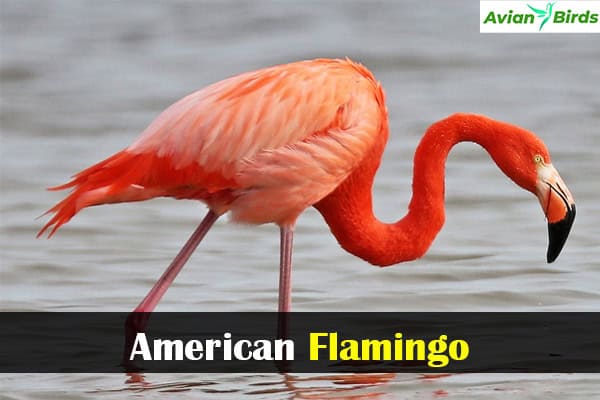
Flamingos: Social Birds in Large Flocks
Flamingos are very social birds that do best in big groups. These groups, called flamboyance, can have hundreds or thousands of birds. They are important for the birds’ survival, helping with food and protecting them from predators.
Understanding a Flamingo’s Flock Behavior
Flamingos in a flamboyance interact in many ways. They form strong bonds, especially during breeding, a trait highlighted in studies at the National Zoo and Conservation Biology. These bonds help them find food and protect their nests.
Studies at the Slimbridge Wetland Centre showed flamingos make friends. They prefer certain friends, whether it’s a same-sex friend or a small group. This shows their choice of who they want to be with.
Collective Nouns for Flamingos: A Flamboyance
The term flamboyance describes a group of flamingos. It fits their bright colors and social nature. The bigger the group, the stronger the bonds between birds.
In breeding seasons, flamingos have more complex social interactions. This strengthens their bonds. But, they are picky about who they befriend, keeping friends for years. Each group is a unique social unit, helping them survive in tough places.
Feeding Habits of Flamingos
Flamingos have special ways to eat, using their flamingo tongues, that help them live in water. They use a filter to eat in places with lots of nutrients. Their body shape is key to how they eat.
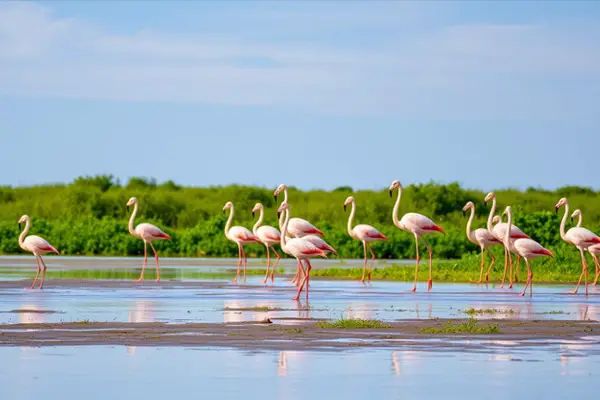
Filter Feeding Mechanism Explained
Flamingos eat by dipping their heads in water and moving them back and forth. This helps them catch food. Their tongues and special parts in their bills act like filters.
Lesser flamingos can filter water up to 20 times a second. Caribbean flamingos do it 4 to 5 times a second. This is important for their diet.
What Flamingos Eat in Their Natural Habitat
In the wild, flamingos eat many things:
- Blue-green and red algae
- Diatoms
- Small crustaceans
- Mollusks
- Small fish
- Insects and aquatic invertebrates
Different flamingos like different foods. Lesser, James and Andean flamingos eat algae and diatoms. Greater, Caribbean, and Chilean flamingos prefer insects and small fish.
Their food also makes them pink. Carotenoid pigments in their diet give them their color.
Flamingos adjust how they eat in different places. In zoos, they get a special diet to stay healthy and pink. They also use their feet to stir up food.
This shows how important filter feeding is for flamingos. It helps them survive in the wild and in zoos, where institutions focus on conservation biology.
The Unique Anatomy of Flamingos
Flamingos have amazing features that help them live well in their homes. Their legs are special, keeping them balanced while they wade. Knowing about their body design helps us see how they fit into their world.
Leg Structure and Its Functions
Flamingos can grow up to 5 feet tall. Their knees are hidden, but their ankle joints look like they bend backward. This trick makes them look different from what we expect.
Their legs are long and strong, helping them stay stable in deep water. They have many joints and muscles. This lets them move well and stand on one leg for a long time.
How Flamingos Stand on One Leg
Flamingos often stand on one leg. This is not just for looks; it helps them survive. Standing on one leg saves energy and keeps them warm in cold water.
They can balance easily on one leg. Their body is made to do this, thanks to strong tendons and muscles. They can stay this way for a long time.
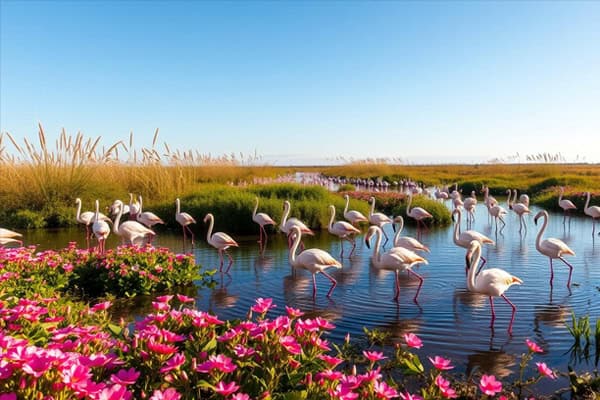
Flamingo Reproduction and Nesting
Flamingos have special ways of making babies that show their strong family ties. They live in groups and do fancy dances to find a mate. They only mate when it’s the right time for building nests and finding food.
Building the Perfect Nest
Both parents work together to build the nest. They use mud, sticks, stones, and feathers to make high mounds. The nest is important to keep the egg dry.
They usually have one egg, but sometimes two, which is crucial for their conservation biology. The egg stays warm for 27 to 31 days. Both parents take turns to keep it warm.
Flamingo Parenting and Crop Milk
When the chick hatches, it’s weak but ready for care. For months, parents feed it special milk from their stomachs. This milk is full of nutrients and has a red color.
Both parents feed and protect the chick. They teach it how to survive. After 5 to 8 days, the chick joins a group for safety.
This group helps the chick avoid dangers like raccoons and foxes. The parents’ hard work helps their chick grow strong in tough places.
| Reproductive Trait | Details |
|---|---|
| First Breeding Age | Approximately 3 to 6 years |
| Clutch Size | Typically one egg, rarely two |
| Incubation Period | 27 to 31 days |
| Chick Mortality Rate | 30% during the first year |
| Caring for Chicks | Both parents feed crop milk |
| Chick Development | Leave nest after 5 to 8 days; join crèches |
Flamingos in Extreme Environments
Flamingos live in many extreme places on Earth. They love places like soda lakes and salty lagoons. These places are too hard for many animals to live in.
Flamingos can live in these hard places because of special traits. These traits help them survive and even thrive in places others can’t.
Habitat Diversity: Saltwater and Soda Lakes
Flamingos live in different places, like saltwater lagoons and soda lakes. These places have brine shrimp and algae. These foods are key to their diet and make them colorful.
The table below shows where live and what these places are like:
| Habitat Type | Characteristics | Flamingo Species Found |
|---|---|---|
| Saltwater Lagoons | High saline concentration, supports a variety of marine life | American Flamingo, Greater Flamingo |
| Soda Lakes | Highly alkaline waters, extreme conditions | Lesser Flamingo, Andean Flamingo |
| High Elevation Wetlands | Up to 4500m; extreme cold and UV exposure | James’s Flamingo |
Physiological Adaptations to Harsh Conditions
Flamingos have special ways to live in extreme places. They have special bills that help them eat small animals from the water. Their skin protects them from the water’s harshness.
They also have special kidneys to get rid of salt. These traits show how well they have adapted to survive in tough places.
The Migration Patterns of Flamingos
Flamingos migrate for food and to breed. Their journeys are key to their survival, especially in regions like East Africa. Each species moves differently based on the weather.
Reasons Behind Their Migration
Flamingos migrate for many reasons. They look for food, avoid crowds, and escape predators. They also move to warmer places in winter.
- Seeking rich food sources during different seasons.
- Avoiding overcrowding and competition for resources.
- Escaping predators and disturbances in their habitat.
- Adapting to droughts or flooding in specific regions.
- Moving to warmer areas during winter months.
Flamingos travel far and wide. They go from short trips to long ones over a thousand miles. This helps them find good places to eat.
How Flamingos Navigate While Migrating
These species are great at finding their way. They use weather and water levels to guide them. They also move together for safety, which is a behavior observed in greater and lesser flamingos.
- Environmental cues like weather conditions and water levels.
- Cohesive flock movements to optimize survival during migration.
- Instinctual navigation to find rich feeding grounds.
The types of Flamingo species migrate at night to avoid predators. Their ability to navigate is truly amazing.
Conservation Status of Flamingos
Flamingos face many challenges that threaten their survival. It’s important to know the threats they face and the efforts to save them. This helps us understand how to protect these amazing birds.
Threats to Flamingo Populations
Habitat loss is a big problem for flamingos. Mining in the Andes harms their wetland homes, highlighting the need for conservation biology initiatives. Climate change also dries up wetlands, affecting their breeding.
The Andean flamingo is listed as Vulnerable. It’s at high risk of extinction soon. These issues are serious and need urgent action.
Conservation Efforts and Strategies
Many groups work to protect flamingos. They use satellite tracking to learn about their movements. This helps in making better plans to save them.
They also educate people about flamingo threats. Programs like “Guardianes y Guardianas de los Flamencos” in Chile teach students about conservation. The SAFE program in the U.S. supports research to help Andean Highland flamingos.
| Flamingo Species | Conservation Status | Main Threats |
|---|---|---|
| Andean Flamingo | Vulnerable | Habitat loss, climate change |
| Chilean Flamingo | Near Threatened | Pollution, habitat degradation |
| Puna Flamingo | Near Threatened | Wetland loss, mining |
| Lesser Flamingo | Near Threatened | Pollution, habitat change |
| Greater Flamingo | Least Concern | General habitat threats |
| American Flamingo | Least Concern | Tourism development |
Flamingo Miscellanea: Fun and Unique Facts
Flamingos are truly amazing birds. They have unique features that amaze us. Their bill shape is one of these, helping them eat better.
Why Flamingos Have a Unique Bill Shape
The bill shape of flamingo types is not just for looks. It helps them eat in saltwater. They use it to filter food from water, leaving out bad stuff.
The Fascinating Behavior of Young Flamingos
Young flamingos are very interesting. They like to be together in groups. This helps them learn and grow up.
| Flamingo Fact | Detail |
|---|---|
| Average Length | 130 cm |
| Weight | Up to 4 kg |
| Leg Structure | 4 fingers with swimming membrane |
| Habitat | Lakes with high salt content and estuaries |
| Feeding Habits | Crustaceans, insects, worms, clams, algae |
| Conservation Status | Least concern in the Red Book |
| Notable Locations include the San Diego Zoo Safari Park, where conservation efforts are emphasized. | Everglades National Park, Sarasota Jungle Gardens, Busch Gardens |
Flamingos in Popular Culture
The types of Flamingo species have made a big splash in our culture. They show up in art and media everywhere, often depicted with their elegant necks. From home decor to books, they symbolize beauty and grace.
Depictions of Flamingos in Art and Media
This species has inspired many artists over the years. They are found in paintings, sculptures, and more. Here are some examples:
- Artwork in Peru that captures the striking presence of flamingos.
- Books for both children and adults featuring flamingos, showcasing their widespread appeal.
- Countless collectibles like magnets and water globes celebrate the flamingo’s unique charm.
Flamingos as Symbols in Various Contexts
Flamingos mean more than just pretty pictures. They play important roles in our society:
- The pink flamingo lawn ornament, first designed in 1957, signifies both affordability and kitsch, connecting to various cultural narratives.
- In the 1990s, yards across South St. Louis featured hot pink flamingos, marking a peak in their popularity as a yard ornament.
- Queer culture has embraced flamingos as symbols of pride and visibility, showcasing their evolving significance.
- The city of Madison recognized the pink flamingo as its official bird, illustrating its cultural importance.
- Some interpret flamingos as signals of openness in relationships, further diversifying their symbolic meanings.
The types of Flamingo species have also been used for fun and irony, like the 1979 prank with 1,008 plastic flamingos at a university. They are also seen as icons of Florida, often featured in zoo and conservation biology institute exhibits. Their meaning is playful yet complex, and it keeps changing.
Read More🐦Related Articles:
| Mesmerizing World of Rosy Starling |
| Common Ostrich (Struthio camelus) |
| Brahma Chicken Care Tips & Facts for Enthusiasts |
| What Do Owls Eat |
| Ducks in Hawaii |
Final Words
In the end, the types of Flamingo show us how important they are. They have amazing adaptations and social behaviors. These traits make them special and help us understand nature better.
Flamingos face challenges like climate change and pollution. But, they still live in many places, mainly in South America. This shows their strength and resilience.
Some flamingos are in danger, but help is working. Places like the Conservancy protect their homes. They also work with local people to keep tourism green.
Protecting flamingos means keeping their homes safe. We must work together to save them. This helps our planet too.
By helping flamingos, we help the world. We can make sure they are here for a long time. Let’s support their protection and share their story.
Frequently Asked Questions
Q1. Can flamingos fly?
Yes, flamingos can fly. They are strong fliers and can travel long distances, often migrating between feeding grounds.
Q2. Where do flamingos live?
Flamingos are found in various parts of the world, primarily in warm, shallow wetlands, lagoons, and coastal areas. Common locations include parts of Africa, the Caribbean, South America, and Asia.
Q3. How to draw a flamingo?
To draw a flamingo, start with a curved neck and an elongated body. Add a long, thin leg and a distinctive beak. Don’t forget the characteristic pink color and the feather details. You can look for step-by-step tutorials online for more guidance.
Q4. Do flamingos fly?
Yes, as mentioned, flamingos can fly and are capable of covering significant distances in the air.
Q5. What do flamingos eat?
Flamingos primarily eat algae, small crustaceans, and other microorganisms found in shallow waters. Their diet gives them their distinctive pink coloration due to carotenoids in the food they consume.
Q6. What is special about flamingos?
Flamingos are known for their striking pink color, long legs, and unique feeding habits. They are also highly social birds, often seen in large flocks.
Q7. Are there flamingos in Pakistan?
Yes, flamingos can be found in Pakistan, particularly in wetlands and coastal areas, such as the Sindh region and some lakes in the Punjab province.
Q8. Which country has flamingos?
Flamingos are found in various countries, including those in Africa (like Kenya and Tanzania), the Caribbean (such as the Bahamas), parts of South America (like Chile), and some regions in Asia (like India and Pakistan).
Q9. Why are flamingos so pink?
Flamingos get their pink coloration from the carotenoid pigments in the algae and crustaceans they eat. The more carotenoids they consume, the pinker they become.
Q10. Why is flamingo famous?
Flamingos are famous for their unique appearance, social behavior, and striking coloration. They are also popular in art and culture, symbolizing beauty and grace.
Q11. What are the 5 characteristics of a flamingo?
- Coloration: Their distinctive pink feathers.
- Long Legs: Adapted for wading in shallow waters.
- Unique Beak: Adapted for filter feeding in mud and water.
- Social Behavior: They live in large colonies for protection and social interaction.
- Migration: Many species migrate seasonally in search of food and suitable breeding grounds.


